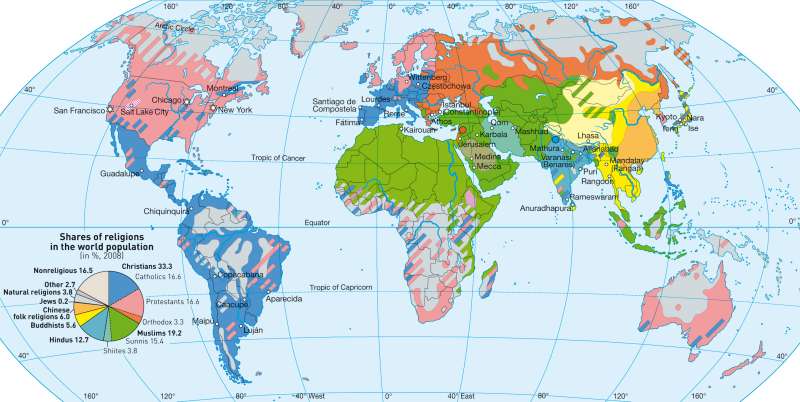The world — Religions
History and religion in maps - Searching for traces
978-3-14-100790-9 | Page 23 | Ill. 3

Information
Christianity has spread to all five inhabited continents over the course of its history. Today, some 2.05 billion people — roughly one-third of the world's population — belong to a Christian denomination.Religions around the globe
Christianity remains the dominant religion in Europe and on the American continents, where a number of primal religions have survived in both the Northern and Southern Hemispheres, albeit only in isolated, sparsely populated, non-industrialized areas. Several Protestant and Catholic majorities are found in sub-Saharan Africa, most notably in the southern and western regions. Christianity is represented in Asia only by Orthodox and Oriental denominations in Russia and the Catholic majority in the Philippines. Nearly 20 million Christians, most of them Protestants, live in Indonesia. In Australia and New Zealand, Anglicans and Catholics, whose communities are nearly identical in size, account for slightly more than half of the population.
Islam has expanded in nearly every direction from the territory occupied for the most part during the 7th and 8th centuries and recruited large numbers of adherents, especially in South and South-East Asia, in northern Africa and along the African east coast. Russia marks the boundary of Islamic expansion to the north. The only Islamic majorities on the European continent are found in Turkey and Albania, while significant minorities live in Bosnia and Herzegovina, Macedonia and Bulgaria.
Following the end of the nearly two-thousand-year Diaspora, the largest number of practising Jews now live in Israel. Jewish communities of different sizes are also found above all in the USA, the largest of these in New York, Chicago and San Francisco.
Buddhism, specifically Mayahana Buddhism, which emerged at the dawn of Christianity, and Lamaism under the leadership of the Dalai Lama, which is also referred to as Tibetan Buddhism, has expanded above all in East Asia, including large portions of China, Myanmar, Laos, Thailand, Cambodia and Vietnam.
Hinduism, an outgrowth of Vedic religion which is closely linked to the Indian caste system, counts some 890 million adherents in India. Considerably smaller is the number of Sikhs, in whose teachings elements of Hinduism are blended with principles of Islam. Most of the roughly 23 million members of this religious reform movement live in the Indian state of Punjab and in communities distributed throughout North America, Great Britain and the Philippines.
Primal religions are found all over the world, with the exception of the European continent. They have survived for the most part in sparsely populated regions in which their geographic isolation, an unfavourable climate or political conflicts have hindered the development of modern forms of production and corresponding societal wealth. Primal religions are encountered in the last remaining natural refuges in South America, near the Arctic Circle, in Oceania, in the interior regions of Australia and in the southern half of Africa.
The map offers an overview of the distribution of the various religions on the globe and their relative dominance in specific regions. However, a map showing the distribution of religious and denominational affiliations inevitably produces a distorted picture. In view of significant differences in population density, the regional expansion of a given religion is hardly a reliable indicator of its social significance. On the other hand, huge religious majorities, such as the 140 million Muslims in India, may be neglected in the cartographic overview. Furthermore, the map does not take large number of people without religious affiliation (a significant percentage of the population in Russia after 74 years of state atheism, for example) into account.
Regardless of the unavoidable generalizations and the relatively unreliable data available in this context, the map can indeed provide valuable insights into the manner in which the different religions have spread. Awareness of the dominant religion in a given part of the world provides the basis for conclusions regarding the genesis of a specific cultural landscape and the nature of the forces at work within it.
K. Lückemeier; Ü: J. Southard




